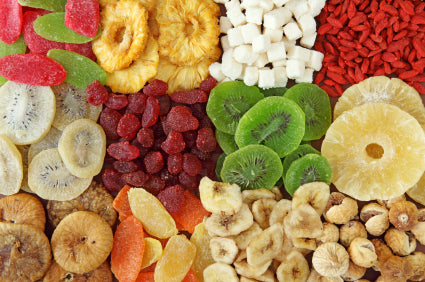Dehydrating has been one of my favorite ways to preserve food—especially foods meant for snacking. It’s an easy way to get the kids involved in storing food and they like being able to choose how we flavor some of their snacks. I love trying to dehydrate different kinds of foods. I have found that I can dehydrate most fruits and vegetables and many kinds of meat, including fish. Here are some things that I have learned over the years that might help you get started.

Dehydrating Tips:
- To prevent browning of fruit or potatoes – dip them in a solution of water and lemon juice before putting them in the dehydrator.
- Remember to cut or slice all fruits, veggies or meats evenly so that they dehydrate in the same amount of time.
- Tomato sauce can be dehydrated like a “fruit roll” and then re-hydrated for cooking at a later time (e.g, spaghetti sauce). We do this for camping. It is much lighter and takes up less space, especially for backpacking.
- For fruit leather – cook fruit first and don’t use sugar it will crystallize during storage. Use honey or corn syrup instead.
- For best results blanch vegetables before dehydrating.
- Always use the freshest, highest-quality foods. Fruits and vegetables should be ripe, but not too soft or mushy.
- Apples don’t need to be peeled to be dehydrated; the peel adds more fiber (and flavor) to your snack.
- Try drying herbs from your garden. Store in zip-top bags or mason jars.
- To flavor apple slices sprinkle with any flavor Jell-o® powder. I use an old bottle that held cake sprinkles to shake the Jell-o® onto the fruit. It works great and the kids love the added flavors.
- When making apple fruit leather always add cinnamon.
- Dehydrators are not just for fruits and jerky. Try making crackers, granola bars and cookies. I have even made dog cookies in mine.
- To prevent tomatoes from dripping in your dehydrator, place trays over your sink, add tomato slices and let them drain before stacking in your dehydrator.
- When making any type of jerky be sure to marinate for several hours. I marinate beef jerky overnight. That gives the flavors time to soak through the meat.
- Be sure to rotate the dehydrating trays so the foods dry evenly.

Dehydrating is a great way to make crunchy, healthy snacks. Have fun with it, and don’t be afraid to experiment. You might be surprised by what you can make.
--Dawn




5 comments
Jill
I like to dehydrate greens – mustad, kale, Swiss chard, broccoli leaves, beet greens, etc, Slice them up, dehydrate, and put in the blender to make a fine powder, Store in small jars with an O2 absorber. I add a teaspoon to my morning smoothie for extra nutrition, and have garden "greens" all year long.
Ann
My kids love it when I make kale chips in the dehydrator! I cover the kale with a little olive oil, salt, pepper, garlic, and Parmesan cheese. I can’t make them fast enough!
Sue
Wow, your picture looks awesome, inspires me to get moving on more of this!:) How do you get it to last longer, do you vacuum pack it by chance? IF so, how long does it last?
:)) Thank you!
Anonymous
Anyone have any information on dehydrating beef chunks, like my favorite Mountain House meats? I'd love to take advantage of the current beef prices and dehydrate and store my own.
I've searched the web, but most instructions are for jerky.
Michael M.
I've made some beef jerky in my oven and it was good, but am saving up for a dehydrator. I can't wait!